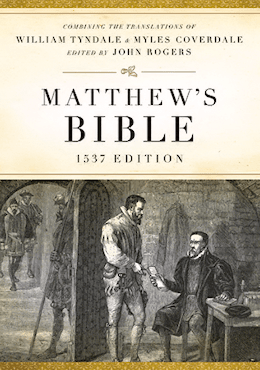Textus Receptus Bibles
Matthew's Bible 1537
| 39:1 | Knowest thou the tyme when the wylde gotes bringe forthe theyr yonge among the stony rockes? Or layest thou wayte when the hyndes vse to fawne? |
| 39:2 | rekeneste thou the monethes after they engendre, that thou knowest the tyme of theyr bearynge? |
| 39:3 | or when they lye doune, when they raste theyr younge ones, & when they are delyuered of theyr trauayle and payne? |
| 39:4 | How theyr younge ones growe vp & waxe greate thorowe good fedynge? |
| 39:5 | who letteth the wylde asse go fre, or who louseth the bondes of the mule? |
| 39:6 | Vnto whom I haue geuen the wyldernes to be their house, & the vntylled lande to be theyr dwellynge place. |
| 39:7 | That they maye geue no force for the multytude of people in the cytyes, neither regard the crying of the dryuer, |
| 39:8 | but seke their pasture aboute the mountaynes, and folow the grene grasse. |
| 39:9 | Whyl the vnicorne be so tame as to do the seruyce, or to abyde styl by thy cryb? |
| 39:10 | Canste thou bynd the yocke about him in thy sorowes, to make him plowe after the in the valleys? |
| 39:11 | Mayest thou trust him (because he is strong) or committe thy laboure vnto hym? |
| 39:12 | Mayest thou beleue him, that he wyll brynge home the corne, or to cary any thyng vnto the barne? |
| 39:13 | The Estrych (whose fethers are fayrer then the wynges of the sparowe hauke) |
| 39:14 | when he hath layed hys egges vpon the ground he bredeth them in the dust, |
| 39:15 | & forgetteth them: so that they myght be troden with fete, or broken with some wylde beaste. |
| 39:16 | So harde is he vnto hys yong ones, as thoughe they were not hys, & laboureth in vayne wythout anye feare. |
| 39:17 | And that because God hath taken wysdome from hym, & hath not geuen hym vnderstandynge. |
| 39:18 | When hys tyme is, he flyeth vp on hye, & careth neyther for horse nor man. |
| 39:19 | Haste thou geuen the horse his strength, or learned him to bowe doune his necke wt feare: |
| 39:20 | that he letteth him selfe be dryuen forthe lyke a greshopper, where as the stoute neyenge that he maketh, is fearfull? |
| 39:21 | he breaketh the grounde with the hoffes of hys fete chearfullye in hys strength, & runneth to mete the harueste men. |
| 39:22 | He layeth a syde all feare, hys stomack is not abated, neyther starteth he a backe for anye swerde. |
| 39:23 | Thoughe the quyuers rattle vpon him though the speare & shyld glystre: |
| 39:24 | yet rusheth he in fearsely, and beateth vpon the grounde, He feareth not the noyse of the trompettes, |
| 39:25 | but as sone as he heareth the shawmes blow, thushe (sayth he) for he smelleth the battell a farre of, the noyse, the Captaynes and the shoutynge. |
| 39:26 | Commeth it thorow thy wisdome, that the Goshauke flyeth towarde the South? |
| 39:27 | Dothe the Aegle mounte vp, and make his neste on hye at the commaundement? |
| 39:28 | He abydeth in the stonye rockes, and vpon the hye toppes of harde mountaynes, where no man can come. |
| 39:29 | From thence maye he beholde his praye, and loke farre aboute wyth hys eyes. |
| 39:30 | His younge ones are fed with bloude, & where any deade bodye lyeth, there is he immediatly. |

Matthew's Bible 1537
The Matthew Bible, also known as Matthew's Version, was first published in 1537 by John Rogers, under the pseudonym "Thomas Matthew". It combined the New Testament of William Tyndale, and as much of the Old Testament as he had been able to translate before being captured and put to death, with the translations of Myles Coverdale as to the balance of the Old Testament and the Apocrypha, except the Apocryphal Prayer of Manasses. It is thus a vital link in the main sequence of English Bible translations.